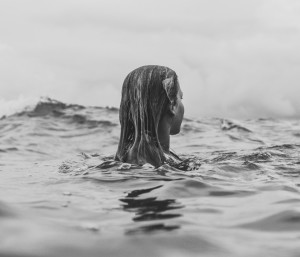When you think of a mermaid, you may conjure images of a kind-hearted, beautiful half-fish, half-human or the dangerous siren that can lure sailors to their death—however, the Inuit legend of the Qalupalik is a little bit different. The Qalupalik is likewise a creature of the sea, but she is more often thought of as a water spirit, a sea monster, or a demon. In this respect, it is said to be more similar to the Japanese Kappa, a water demon who steals children and consumes them. Folklore recorded from Inuit sources are purposefully vague on whether or not the Qalupalik is the only one of her kind, or whether there are great numbers of these monsters living in the Arctic seas, but she is regularly referenced as being a single creature.
Legend of the Inuit Siren
In Alaskan and Canadian Inuit culture, there are Arctic ocean-dwelling creatures known as Qalupaliit (kah-loo-pah-leet)—unlike other mythical mermaids and sirens, there is absolutely nothing attractive about the Qalupalik. Despite the persistent popular mermaid princess culture that surrounds much of the lore of this aquatic creature’s cousins in lore, the Qalupalik (kah-loo-pah-leek) is not described as having any pleasant features, let alone an amenable demeanor. Wraith-like in appearance, her long black hair is perpetually plastered to her sallow, slimy, scaly skin—her ghastly despondent face is paired with her dark and hollow eyes. These creatures are often depicted as having fins that jut out of their heads, backs and arms, and their webbed feet and hands are topped with long sharp claws—all of this is enough to strike terror into the hearts of the children that the Qalupalik preys upon.
The Qalupalik is rumored to reek of sulfur—you know, the smell of rotting eggs? So it’s curious that she would ever get close enough to someone without them noticing, but adventurous children who don’t heed the warnings of their parents are the ones she seeks to claim; she hums beautiful melodies to lure them to the icy banks of the ocean’s shore where she snatches them up and stuffs them in her amauti, a duck-skin coat similar to a parka with a pouch for young children to be carried in. It’s quite normal for Inuit parents to caution their children about the dreadful Qalupalik and they would do so frequently, telling their children that if they hear the humming noise near the shore that the Qalupalik is near. Unfortunately for children, the humming is similar to that of a Siren’s song, as it is meant to entice children to come closer to the shore or out onto the dangerously thin ice.
Those who have sighted the Qalupalik report that these creatures can only be seen for an instant before they are gone, but the child victims of the Qalupalik would not be as lucky. She would leap out from under the water, sink her shark claws into their flesh and drag them forward into the water. It is said, once she seizes a child, she takes them down to the freezing depths of the ocean where she either eats them, or takes them away enchanting them with sleep and feeding off of their youth so that she may remain young forever; the child is never to be seen or heard from by their family again. Alternatively, the child would get a brief glimpse of the face of the Qalupalik, which might resemble a woman’s face that had turned green and bloated from rotting and under the sea—this child would experience their last few moments of life in pain as the freezing water rushed into their open, screaming throat, and feel the blood in their veins freeze as they heard the distant voices of their family, crying out their name.
So what purpose does the myth of the Qalupalik serve for the Inuit society? Well, the harsh arctic environment within which the Inuit people live is terrifying and dangerous; within a community that works so hard to survive, the parents and elders used storytelling as a way of aiding in the upbringing and survival of the children of the village. Essentially, the use of scare-tactics was a way for children to avoid the dangerous aspects of their environment when they were alone,. The story of the Qalupalik was created to encourage these children to fear to be alone near the dangerous shores of the sea, where they could easily fall prey to the natural elements by either drowning or dying from hypothermia.
Tales & Traditions: Qallupilluit
The Central Eskimo (1888) recorded by Franz Boas
An old woman lived with her grandson in a small hut. As they had no kinsmen they were very poor. A. few Inuit only took pity on them and brought them seal’s meat and blubber for their lamp”. Once upon a time, they were very hungry and the boy cried. The grandmother told him to be quiet, but as he did not obey she became angry and called Qallupilluk to come and take him away. He entered at once and the woman put the boy into the large hood, in which he disappeared almost immediately.
Later on the Inuit were more successful in sealing and they had an abundance of meat. Then the grandmother was sorry that she had so rashly given the boy to Qallupilluk and wished to see him back again. She lamented about it to the Inuit, and at length a man and his wife promised to help her.
When the ice had consolidated and deep cracks were formed near the shore by the rise and fall of the tide, the boy used to rise and sit alongside the cracks, playing with a whip of seaweed, Qallupilluk, however, was afraid that somebody might carry the boy away and had fastened him to a string of seaweed, which he held in his hands. The Inuit who had seen the boy went toward him, but as soon as he saw them coming he sang, “Two men are coming, one with a double jacket, the other with a foxskin jacket” (Inung maqong tikitong, aipa mirqosailing. aipa kapiteling). Then Qallupilluk pulled on the rope and the boy disappeared. He did not want to return to his grandmother, who had abused him.
Some time afterward the Inuit saw him again sitting near a crack. They took the utmost caution that he should not hear them when approaching, tying pieces of deerskin under the soles of their boots. But when they could almost lay hold of the boy he sang, “Two men are coming, one with a double jacket, the other with a foxskin jacket.” Again Qallupilluk pulled on the seaweed rope and the boy disappeared.
The man and his wife, however, did not give up trying. They resolved to wait near the crack, and on one occasion when the boy had just come out of the water they jumped forward from a piece of ice behind which they had been hidden and before he could give the alarm they had cut the rope and away they went with him to their huts.
The boy lived with them and became a great hunter.
Nunavut Animation Lab: Qalupalik
Nunavut Animation Lab created an animated version of one of the traditional tales about the Qalupalik, just like all of the folklore originating in Alaskan Native culture, there is always a moral to the story. This is an example of one told to children, to inform them of the dangers of not obeying their parents and wandering by the icy coastal waters on their own. Not to be mistaken with her more traditional lore, the video (linked below) describes a circumstance where the child who was kidnapped is rescued by his father, which of course is not what would typically happen if a child were kidnapped by this Inuit monster of the deep.
Mythical Monsters Podcast: Qalupalik
Another excellent resource for this particular mythical beast is Mythical Monsters Podcast who produced this podcast episode entitled “Qalupalik”. Check it out below!
The Qalupalik (2011)
An even less traditional take on the legend of the Qalupalik was fairly recently made into a children’s book, but it errs more on the side of child-friendly, where it suggests that despite her frightful appearance, she is rather easily tricked. It’s clear through all of the recent reimaginings of the legend of the Qalupalik that this story is still very widely told within Inuit communities, where the parents and teachers alike share this story with the children of the village in order to protect them from a curious and wandering nature.
The Qalupalik (2011) by Elisha Kilabuk is a mystical Inuit tale that has been reworked from its original well-known narrative. In the original folk tale, the children are always considered the victims and much like the grim nature of the folk tales told by the Brothers Grimm, the story ends without coming to the realization of a happy ending. In this version, we see the new tradition of vulnerable children, or the underdog, outsmarting the monster that happens to be bigger, older, and stronger than themselves; an orphan gets the better of the Qalupalik and survives an encounter with the monster.
This is the first book in the Inhabit Media’s Unikkakuluit Series, which features traditional native folklore being retold in new and interesting ways—while these stories pay homage to the original oral tradition of storytelling, they give the newest generation their own stories to identify with. Despite illustrator Joy Ang creating an incredibly frightening visage for these creatures, her illustrations are incredible and the story they sit alongside can give the meekest child reassurance that even the scariest of opponents will have a weakness that can be exploited.
Works Cited
Akulukjuk, Roselynn. “PUTUGUQ & KUBLU AND THE QALUPALIK.” Kirkus Reviews, Inhabit Media, 7 May 2019.
Houston, James. “Inuit Myth and Legend“. The Canadian Encyclopedia, 04 March 2015, Historica Canada. Accessed 17 December 2020.
Hrodvitnir, Yamuna. “Qalupalik: The Monstrous Inuit Mermaid.” Medium, Medium, 26 May 2020.
“INUIT MYTHOLOGY.” Inuit Mythology.
Kilabuk, Elisha, and Sarah Sorensen. “The Qalupalik.” Quill and Quire, 30 June 2011.
National Film Board of Canada. “Nunavut Animation Lab: Qalupalik.” National Film Board of Canada, 2 Dec. 2010.
Oliver, Mark. “11 Mythological Creatures That Reveal Humanity’s Deepest Fears.” All That’s Interesting, All That’s Interesting, 17 June 2020.
Pfeifle, Tess. Qalupalik. 8 Jan. 2019, www.astonishinglegends.com/astonishing-legends/2019/1/7/qalupalik.
“Qalupalik.” Mythpedia Wiki, mythpedia.fandom.com/wiki/Qalupalik.
“Tales and Traditions.” The Central Eskimo: Introd. by Henry B. Collins, by Franz Boas, Smithsonian Institution, Bureau of Ethnology, 1888, pp. 212–213.

Georgia-based author and artist, Mary has been a horror aficionado since the mid-2000s. Originally a hobby artist and writer, she found her niche in the horror industry in late 2019 and hasn’t looked back since. Mary’s evolution into a horror expert allowed her to express herself truly for the first time in her life. Now, she prides herself on indulging in the stuff of nightmares.
Mary also moonlights as a content creator across multiple social media platforms—breaking down horror tropes on YouTube, as well as playing horror games and broadcasting live digital art sessions on Twitch.


